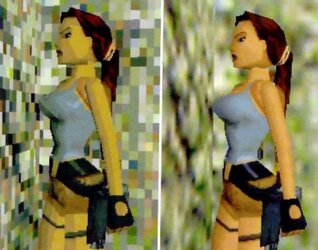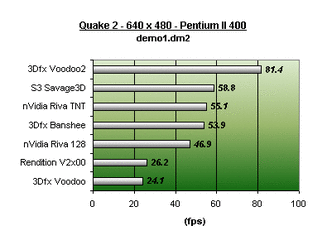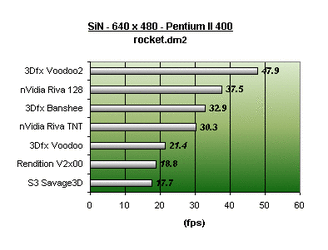3DFX in a few short years went from a literally who made of a few former engineers from SGI to dominating force in 3d graphics to dying on the vine to being bought by their main competitor Nvidia between late 1996 and march of 2000.
3DFX created the VooDoo line of cards, these cards were on the early 3D scene where standards didnt really exist. 3DFX brought with it the Glide API, which allowed developers to code close to the metal in a way the then nacent Direct X and open GL didnt allow. Developers loved it for its consistency and capabilities, and gamers loved it for allowing the OG voodoo to play at such lofty resolutions as 640x480. The followup voodoo 2 could push 3d graphics at 800x600, or 1024x768 with 2 cards, while their competitors still performed best at 320x240. Notably, this dual 12MB voodoo 2 arrangement was capable of running Doom 3, a game that came out 7 years later using much more modern technology. Glide allowed for far better performance then DirectX or OpenGL, and many flat out looked better on top of running better with 3DFX hardware.
See here: examples of 3DFX rendering VS software (as unreal's DX renderign was useless) and DX vs Glide in tomb raider


3DFX really was the titan of its industry:


Then they tried to become a vertical company. They bought STB, an add in card maker, with the intention of making their own GPUs for distribution. This royally pissed off other AIB makers, who promptly switched to making cards with nvidia GPUs or cards using new silicon from this tiny startup called "ATi". Shortly after this an earthquake partially crippled the mexican factory for months, leading to 3DFX being unable to make enough cards to supply big OEMs like dell and HP. As none of the other AIBs would work with 3DFX anymore, big OEMs started using nvidia cards and ATi cards instead.
This was a huge blow to 3DFX. They had gotten their API out there on the back of OEM systems. The DIY market was far smaller then compared to today. OEMs expected products on time, and not only did 3DFX fail this, they also failed to deliver the performance. Previous generations of VooDoo were 3D only, and required a separate 2D card. 3DFX was able to achieve this with VooDoo 3, but 2D faltered in comparison to the TNT and 3D improvements had been put on the backburner. Now with direct X 7 on the scene and new GPUs from Nvidia performing better then the voodoo 3 Glide and 3DFX were falling from grace.
A year earlier 3DFX had been working with SEGA on their new console, the dreamcaset. These documents were made public as part of 3DFX's IPO, enraging SEGA, who promptly tore up the contract with 3DFX and went with NEC for better and worse (side note, EA cited the NEC GPU as being one of the major reasons they didnt want to make games for the dreamcast. OOPS).
With funds dwindling, 3DFX was left at a crossroads. They had 2 GPU projects in the pipeline, the VSA 100, a upgraded redesign of their earlier designs, and a totally new chip called "RAMPAGE" that was supposed to be a new revolution of 3D graphics. 3DFX decided the best idea would be to pursue both projects.
The VSA (VooDoo Scalable Architecture) was originally designed to take on the TNT2. Due to delays partially tied to lack of funding, the geforce 256 released first, which moved more tasks from the CPU to the "GPU", as this was the first card that was more then an accelerator. So VSA (codenamed NAPALM) was delayed and reconfigured to run in a MCM configuration similar to the VooDoo 2. This was accomplished, but by the time it came out the Geforce 2 Ti line came out and ROFLstomped the VooDoo cards in every test imaginable outside of Glide games. And since new Glide accelerators were few and far between most devs had moved to openGL or DirectX. Sales were abysmal, and by march of 2000 3DFX was absorbed by Nvidia.
They really were ahead of their time though, and left quite a legacy. The MPEG and Hardware T&L hardware that 3DFX was working on for RAMPAGE was far superior to late 90s tech, and would eventually find its way to the Geforce 4 lineup. RAMPAGE itself bore some similarity to the ill fated FX 5900 series, and scuttlebutt from long deleted forums was that much of the rampage design was put into the FX series, suggesting that 3DFX, if they had the money, could have produced a 5900 level card 3 years earlier then Nvidia could. 3DFX engineers eventually created the Scalable Link Interface (SLI) for nvidia, which worked totally differently from 3DFX's Scan Line Interleave (SLI) tech. Some of the engineers didn't fancy working for nvidia though, and jumped ship to the startup ATi, where they would be responsible for CrossFire, ATi's multi-GPU technology (notice a pattern here?). Notably, the OG crossfire worked more similarly to 3DFX's tech then modern CrossFire.
It's a cautionary tale of flying too close to the sun expanding as fast as possible, and why sometimes you need bean-counters in charge alongside engineers.



